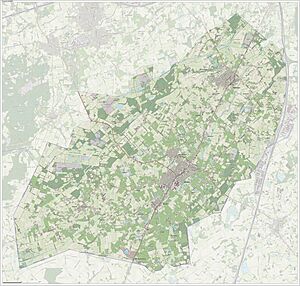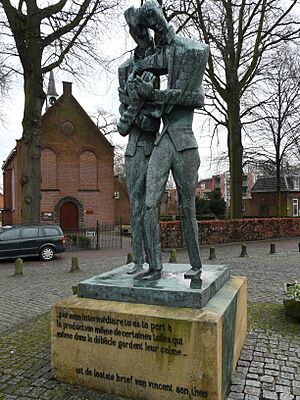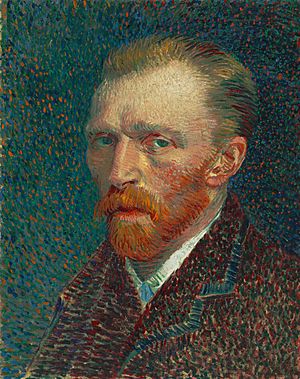Zundert facts for kids
Quick facts for kids
Zundert
|
|||
|---|---|---|---|

Zundert city hall in 2021
|
|||
|
|||
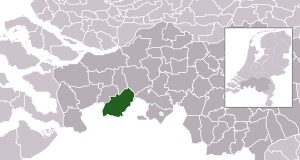
Location in North Brabant
|
|||
| Country | Netherlands | ||
| Province | North Brabant | ||
| Government | |||
| • Body | Municipal council | ||
| Area | |||
| • Total | 121.17 km2 (46.78 sq mi) | ||
| • Land | 120.78 km2 (46.63 sq mi) | ||
| • Water | 0.39 km2 (0.15 sq mi) | ||
| Elevation | 12 m (39 ft) | ||
| Population
(May 2014)
|
|||
| • Total | 21,555 | ||
| • Density | 178/km2 (460/sq mi) | ||
| Demonym(s) | Zundertenaar, Zundernaar | ||
| Time zone | UTC+1 (CET) | ||
| • Summer (DST) | UTC+2 (CEST) | ||
| Postcode |
4880–4891
|
||
| Area code | 076 | ||
Zundert is a municipality and town in the southern part of the Netherlands. It is located right next to the border with Belgium, in the province of North Brabant.
Zundert is famous for being the birthplace of the well-known Post-Impressionist painter Vincent van Gogh.
Contents
History of Zundert
The name Zundert was first written down in a document from 1157. This document mentioned a place called "Sunderda." This name actually referred to what is now known as Klein-Zundert, which means "Small Zundert." It was one of the first settlements in this area.
Local monks played a big role in the early days. Besides their religious work, they helped clear the land. This land was wild, with many swamps, peats, and heath fields. The monks also taught people better ways to farm.
Today, Zundert is still surrounded by beautiful nature. One of these areas is the "Buissche Heide," a heathland perfect for walks and recreation. The Kalmthoutse Heide, which is just across the border in Belgium, is also very close by.
During Second World War, Zundert and its nearby villages were freed. This happened during an important operation called Operation Pheasant. Zundert, Achtmaal, Wernhout, and Klein-Zundert were liberated on October 27, 1944. Rijsbergen was freed on October 28. American soldiers from the 104th Infantry Division helped liberate these areas.
Close to the town, you can find an old tavern called "In Den Anker." This tavern has the oldest license in the Netherlands. It was first built in 1635, but it was rebuilt in 1913.
Geography and Farming
The municipality of Zundert includes several places. These are:
- Zundert (the main town)
- Rijsbergen
- Klein-Zundert
- Wernhout
- Achtmaal
Zundert is about 12 meters (about 39 feet) above the Dutch sea level. It is located about 15 kilometers (9 miles) southwest of the city of Breda. It is also about 35 kilometers (22 miles) northeast of Antwerp, a city in Belgium.
Zundert is one of the most agricultural municipalities in the Netherlands. This means farming is very important here. About 10% of all nursery plants grown in the Netherlands come from around Zundert. Growing strawberries and young trees for gardens and hedges is a very big business in this area.
Architecture and Buildings
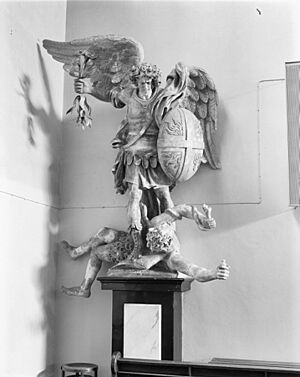
The Roman Catholic church in Zundert is called Saint Trudo Church. It was built in 1927. Inside, it holds special art pieces from the 1600s. These treasures came from the St. Michielsabdij in Antwerp. They include marble altars, three alabaster sculptures, paintings, and two carved wooden confessionals. One of the sculptures was made by the famous Flemish artist Peter Paul Rubens. The church itself was designed by Jan Stuyt, a student of another famous architect. Stuyt also designed the church in nearby Klein-Zundert.
The town hall of Zundert was built in 1830 in a classic style. It was torn down and rebuilt in the same style in 1965.
The Netherlands' first female architect, Margaret Staal-Kropholler, built a studio in 1919. This studio was for the artist Richard Roland Holst and his wife, the poet Henriëtte Roland Holst-van der Schalk. It was built on the Buissche Heide and shows the style of the Amsterdam School.
Windmills in Zundert
Zundert is home to a 17th-century windmill called 'De Akkermolen'. People believe it was first built in 1652. It is a traditional mill used to grind grain.
Over the years, the mill had many different owners. This included stadtholder Willem V, who became its owner in 1794. In the early 1900s, Wilhelmus van der Stappen owned the mill.
The mill was badly damaged in 1950. Its future was uncertain many times after that. The Akkermolen is now owned by the municipality of Zundert. They bought it in 1959. The last private owners were the Herijgers family. After Zundert took over the mill, it needed a lot of repair. This first happened in 1961. Another big restoration took place in 1991, where the whole mill had to be taken apart and fixed.
You can visit the Akkermolen by making an appointment. It is located at Akkermolenweg 15.
Zundert used to have other mills too. One was a stone mill called "De Eendracht." It burned down on January 23, 1909. The owner had already lost another wooden mill in Zundert the year before. A store is now located where this mill once stood.
Vincent van Gogh's Hometown
Zundert is the place where the famous painter Vincent van Gogh was born and grew up. He was born on March 30, 1853, in a small house on Zundert's main street, Markt 29. That original house is no longer there because it was too old to save. However, a special plaque marks the spot where he was born. In August 2008, the Vincent van Gogh House opened after the renovation of Markt 29 and the house next door.
You can still visit the Dutch Reformed church built in 1806. Vincent's father, Theodorus van Gogh, started preaching there in 1849. In the churchyard, you can find the grave of Vincent's older brother, who also died as a baby and was named Vincent van Gogh. Vincent did not paint much when he lived in Zundert, but he did draw some sketches. In letters to his brother Theo, Vincent often remembered Zundert. He wrote about his childhood, peace, and learning about life there.
Vincent died in the French town of Auvers-sur-Oise. Because of this, Zundert and Auvers-sur-Oise have a special connection. For example, there is a street in Zundert called Auvers-sur-Oise Street, which leads to the Van Gogh Square.
To honor Vincent's memory, the municipality of Zundert created the Vincent van Gogh House. It is not a typical museum. Instead, it is an active place with information about Van Gogh's life. It offers interactive learning, a research room, and both permanent and changing art shows. You can also find tourist information there, along with a nice cafe and garden.
There is a bronze statue of Vincent and his brother Theo on the "Vincent van Gogh Plein" (Vincent van Gogh Square). The statue was made by the French artist Ossip Zadkine. It was officially revealed on May 28, 1964, by the former Dutch queen Juliana. The statue shows the special bond between Vincent and his brother Theo. Many activities related to Van Gogh happen here. You can get tourist information and join activities at the Vincent van Gogh House, which is across from the town hall.
Zundert Flower Parade
The Bloemencorso Zundert (Flower Parade Zundert) first took place in 1936. It was held to honor Queen Wilhelmina of the Netherlands. This makes it the oldest and most detailed flower parade in Europe. Every year, the parade starts on the first Sunday of September. The amazing flower floats stay on display for the next day, Monday, which is a holiday for the people living there. On Tuesday morning, the floats are taken apart.
This is the largest flower parade in the world. Up to 50,000 people visit it every year. Huge, impressive sculptures, built on lorries and covered in thousands of dahlia flowers, roll through the town. Rules about the size of the floats were set in 1989. This was to make sure the parade could safely pass through Zundert's streets. The people of Zundert consider it an honor to push these floats, which are usually moved by volunteers.
Twenty different hamlets (small villages) compete in the Bloemencorso Zundert. Each hamlet builds its own float. They are all made up of volunteers. These twenty groups have their own culture, identity, flags, and dahlia fields. These fields are in and around the municipality and grow the flowers for the parade. Together, they have about 33 hectares (81 acres) of land. They grow 600,000 dahlia plants in 50 different colors and types. The members of each hamlet plant and pick the flowers themselves. They grow about 6 million dahlias in Zundert. The entire parade needs 8 million dahlias each year. If they need more flowers, the Bloemencorso Zundert gets them from other flower parades and a few professional growers.
On October 13, 2012, the Bloemencorso Zundert became the first Dutch tradition to be listed on the national inventory of the UNESCO Convention for the Protection of Intangible Cultural Heritage. This means it is recognized as an important cultural tradition. This was announced during the parade on September 2, 2012.
The Bloemencorso Zundert was canceled in 2020 because of the global COVID-19 pandemic. This was the first time it was canceled since the Second World War. In 2022, the flower parade took place on September 4.
Notable People from Zundert
Many interesting people have lived in Zundert, including:
- Hendrik Detmers (1761–1825), a Dutch general who fought in the Battle of Waterloo.
- Vincent van Gogh (1853–1890), the famous Dutch painter.
- Theo van Gogh (1857–1891), an art dealer and Vincent van Gogh's brother.
- Wil van Gogh (1862–1941), a Dutch feminist and the youngest sister of Vincent and Theo van Gogh.
- Janus Braspennincx (1903–1977), a Dutch racing cyclist who won a silver medal at the 1928 Summer Olympics.
- Johan van der Velde (born 1956), a former Dutch cyclist.
- Jacques Hanegraaf (born 1960), a retired Dutch road bicycle racer who competed in the 1980 Summer Olympics.
- Jelle Nijdam (born 1963), a former professional cyclist who competed in the 1984 Summer Olympics.
- Jacco Verhaeren (born 1969), a Dutch swimming coach who was named Netherlands Coach of the Decade in 2010.
- Vera Siemons (born 1993), a Dutch radio DJ and podcast creator.
Images for kids
See also
 In Spanish: Zundert para niños
In Spanish: Zundert para niños




